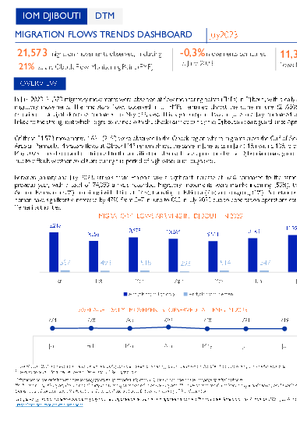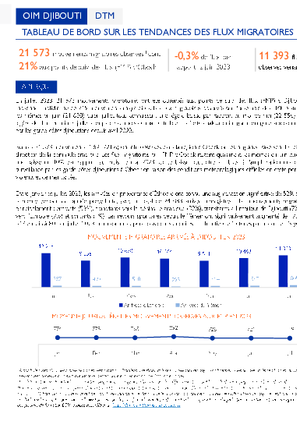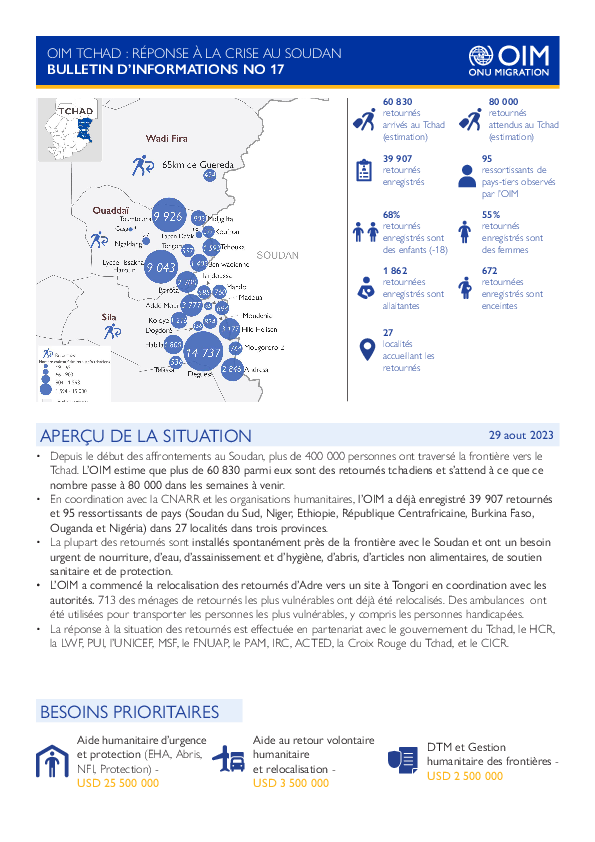-
Countries
-
Data and Analysis
-
Special Focus
-
Crisis Responses

Contact
DTM Djibouti, DTMDjibouti@iom.int
Language
English
Location
Djibouti
Period Covered
Jul 01 2023
Jul 31 2023
Activity
- Flow Monitoring
In July 2023, 21,573 migratory movements were observed at flow monitoring points (FMPs) in Djibouti, with a daily average of 719 migratory movements. The migratory flows observed in all FMPs remained almost the same in June (21,630) as in July, all experiencing a slight decrease compared to May (22,556). This slight drop in flows in June and July compared to May remains linked to the strong heat which reigns combined with the checks carried out by the Djiboutian coast guard since April 2023.
Of these 21,573 movements, 4,621 (21%) were observed in the Obock region where migrants cross the Gulf of Aden towards the Arabian Peninsula. Migratory flows at Obock FMP remain almost the same in June as as in July (-1%) with a 10% drop compared to May 2023. This drop can be attributed to the amplification of surveillance operations by the Djiboutian coast guards in Obock and due to difficult weather conditions during this period of high winds and rough seas.
Between January and July 2023, arrivals from Ethiopia saw a significant increase of 52% compared to the same period of the previous year, with a total of 74,083 arrivals recorded. Migratory movements were mainly: incoming (53%), transiting to the Arabian Peninsula (32%), transiting inside Djibouti (7%), transiting to Ethiopia (7%) and outgoing (1%) . Spontaneous returns from Yemen have significantly increased by 47%, from 547 in June to 805 in July 2023 due to deportation operations carried out by the Yemeni authorities.

Contact
DTM Djibouti, DTMDjibouti@iom.int
Language
French
Location
Djibouti
Period Covered
Jul 01 2023
Jul 31 2023
Activity
- Flow Monitoring
En juillet 2023, 21 573 mouvements migratoires ont été observés aux points de suivi des flux (FMP) à Djibouti, avec une moyenne quotidienne de 719 mouvements migratoires. Les flux migratoires observés sur l'ensemble des FMP restent quasiment les mêmes en juin (21 630) qu’en juillet tous connaissant une légère baisse par rapport au moi de mai (22 556). Cette baisse légère des flux en juin et juillet comparée au mois de mai reste liée à la forte chaleur qui règne conjuguée aux contrôles effectués par les garde-côtes djiboutiens depuis avril 2023.
Sur ces 21 573 mouvements, 4 621 (21%) ont été observés dans la région d'Obock où les migrants traversent le golfe d'Aden en direction de la péninsule arabique. Les flux migratoires aux FMP d'Obock restent quasiment les mêmes en juin qu’en juillet avec une baisse de 10% par rapport au mois de mai 2023. Cette baisse peut être attribuée à l'amplification des opérations de surveillance par les garde-côtes djiboutiens à Obock en raison des conditions météorologiques difficiles en cette période de vents violents et de mer agitée.
Entre janvier et juillet 2023, les arrivées en provenance d'Éthiopie ont connu une augmentation significative de 52% par rapport à la même période de l'année précédente, avec un total de 74 083 arrivées enregistrées. Les mouvements migratoires étaient principalement : entrants (53%), transitants vers la péninsule arabique (32%), transitants à l'intérieur de Djibouti (7%), transitants vers l'Éthiopie (7%) et sortants (1%). Les retours spontanés depuis le Yémen ont significativement augmenté de 47%, passant de 547 en juin à 805 en juillet 2023 en raison des opérations de reconduites à la frontière effectuées par les autorités yéménites

Contact
DTM Zimbabwe, DTMzimbabwe@iom.int, DTMsupport@iom.int
Language
English
Location
Zimbabwe
Period Covered
Jul 01 2023
Jul 31 2023
Activity
- Flow Monitoring
During the month of July 2023, a total of 45,194 movements were recorded and 3,186 migrants were interviewed across 41 Flow Monitoring Points (FMPs) in Zimbabwe. The total movements recorded decreased by 5% compared to the previous month. Sixty-four per cent of movements observed were inflows, whilst 36% were outflows. The top three sending districts were Beitbridge (48%), Harare (14%) and Chiredzi (6%). Matabeleland South province recorded the highest number of outflows (53%) whilst Harare province recorded the highest number of inflows (35%).
The South Africa-Zimbabwe corridor recorded the highest movement of 37,110 (82%) followed by the Zambia-Zimbabwe corridor which recorded 5,108 (11%) movements. Forty-two per cent of movements along the South Africa-Zimbabwe corridor were short-term movements, 25% were long-term economic movements whilst 17% were for family reunification. Of the migrants travelling from South Africa, 31% were going to Harare, 22% to Beitbridge and 7% to Bulawayo.
The Zambia-Zimbabwe corridor consisted of 59% short-term movements, 23% family reunification movements and 18% long-term movements. Of the migrants travelling to Zambia, 85% were travelling from Harare, 6% from Bulawayo and 4% from Karoi.
Migrants travelling from Matabeleland South highlighted Limpopo (68%) and Gauteng (22%) as their intended destinations. Of the incoming migrants travelling to Harare, 44% were travelling from Gauteng, 24% from Lusaka and 16% from Western Cape.

Contact
DTM Zimbabwe, DTMzimbabwe@iom.int, DTMsupport@iom.int
Language
English
Location
Zimbabwe
Period Covered
Jun 01 2023
Jun 30 2023
Activity
- Flow Monitoring
During the month of June 2023, a total of 47,799 movements were recorded and 3,337 migrants were interviewed across 41 Flow Monitoring Points (FMPs) in Zimbabwe. The total movements recorded decreased by 1% compared to the previous month. Sixty-five per cent of movements observed were inflows, whilst 35% were outflows. The top three sending districts were Beitbridge (47%), Harare (14%) and Chiredzi (7%). Matabeleland South province recorded the highest number of outflows (52%) and Harare province recorded the highest number of inflows (36%).
The South Africa-Zimbabwe corridor recorded the highest movement of 37,308 (78%) followed by the Zambia-Zimbabwe corridor which recorded 5,754 (12%) movements. Thirty-four per cent of movements along the South Africa-Zimbabwe corridor were family reunification movements, 32% were short-term local movements whilst 25% were long-term economic movements. Of the migrants travelling from South Africa, 32% were going to Harare, 23% to Beitbridge and 10% to Bulawayo. Migrants travelling from Matabeleland South highlighted Limpopo (69%) and Gauteng (23%) as their intended destinations. Of the incoming migrants travelling to Harare, 39% were travelling from Gauteng, 25% from Lusaka and 13% from Western Cape.
The Zambia-Zimbabwe corridor consisted of 69% short-term movements, 17% long-term economic movements and 13% family reunification movements. Fifty-five percent of migrants travelling to Zambia were travelling to conduct commercial activities whilst 15% were going to access services. Of the migrants travelling to Zambia, 79% were travelling from Harare, 5% from Bulawayo and 5% from Kariba.

Contact
DTM Zimbabwe, DTMzimbabwe@iom.int, DTMsupport@iom.int
Language
English
Location
Zimbabwe
Period Covered
May 01 2023
May 31 2023
Activity
- Flow Monitoring
During the month of May 2023, a total of 48,360 movements were recorded and 3,712 migrants were interviewed across 34 Flow Monitoring Points (FMPs) in Zimbabwe. The total movements recorded increased by 19% compared to the previous month. Sixty-three per cent of movements observed were inflows, whilst 37% were outflows. The top three sending districts were Beitbridge (44%), Harare (14%) and Chiredzi (6%). Matabeleland South province recorded the highest number of outflows (49%) and Harare province recorded the highest number of inflows (26%).
The South Africa-Zimbabwe corridor recorded the highest movement of 36,669 (76%) followed by the Zambia-Zimbabwe corridor which recorded 6,200 (13%) movements. Thirty-two per cent of movements along the South Africa-Zimbabwe corridor were family reunification movements. Of the migrants travelling from South Africa, 30% were going to Harare, 18% to Beitbridge and 10% to Bulawayo. Twenty-nine per cent of movements along the South Africa-Zimbabwe corridor were short-term local movements whilst 28% were long-term economic movements.
The Zambia-Zimbabwe corridor consisted of 67% short-term movements, 16% long-term economic movements and 14% family reunification movements. Fifty-two percent of migrants travelling to Zambia were travelling to conduct commercial activities. Of the migrants travelling to Zambia, 72% were travelling from Hurungwe whilst 14% were from Bulawayo.
Migrants travelling from Matabeleland South highlighted Limpopo (61%) and Gauteng (32%) as their intended destinations. Of the incoming migrants travelling to Harare, 38% were travelling from Limpopo, 34% from Gauteng and 11% from Lusaka.

Contact
DTM Zimbabwe, DTMzimbabwe@iom.int, DTMsupport@iom.int
Language
English
Location
Zimbabwe
Period Covered
Apr 01 2023
Apr 30 2023
Activity
- Flow Monitoring
During the month of April 2023, a total of 40,674 movements were recorded and 2,545 migrants were interviewed across 34 Flow Monitoring Points (FMPs) in Zimbabwe. The total movements recorded decreased by 7% compared to the previous month. Sixty-three per cent of movements observed were inflows, whilst 37% were outflows. The top three sending districts were Beitbridge (47%), Harare (13%) and Chiredzi (7%). Matabeleland South province recorded the highest number of outflows (52%) and Harare province recorded the highest number of inflows (36%).
The South Africa-Zimbabwe corridor recorded the highest movement of 31,656 (78%) followed by the Zambia-Zimbabwe corridor which recorded 4,761 (12%) movements. Thirty-four per cent of movements along the South Africa-Zimbabwe corridor were short-term local movements. Of the migrants travelling from South Africa, 32% were going to Harare, 19% to Beitbridge and 12% to Bulawayo. Twenty-six per cent of movements along the South Africa-Zimbabwe corridor were long-term economic movements whilst 26% were for family reunifications.
The Zambia-Zimbabwe corridor consisted of 69% short-term movements and 14% long-term economic movements. Fifty-one percent of migrants travelling to Zambia were travelling to conduct commercial activities. Of the migrants travelling to Zambia, 72% were travelling from Hurungwe, and 14% from Bulawayo.
Outgoing migrants who had departed from Matabeleland South highlighted Limpopo (61%) and Gauteng (32%) as their intended destinations. Of the incoming migrants travelling to Harare, 38% were travelling from Limpopo, 34% from Gauteng and 11% from Lusaka.

Contact
DTM-OSE: dtmvzaresponse@iom.int
Language
Spanish
Location
Panama
Period Covered
Jun 01 2023
Jun 30 2023
Activity
- Flow Monitoring Survey
- Flow Monitoring
La provincia del Darién se ubica en la frontera este de Panamá́, y su territorio forma parte de las rutas migratorias más utilizadas por personas en situación de movilidad humana por las Américas para migrar desde el sur hacia el norte del continente. A su vez, esta ruta es altamente peligrosa por las características geográficas de la selva y la presencia de crimen organizado. Las personas que la transitan se encuentran expuestas a riesgos varios como la trata de personas, tráfico ilícito, violencia basada en género, diversas formas de explotación y abuso. El uso de estas rutas inseguras para llegar a destinos temporarios o finales plantea amenazas para la integridad, dignidad y la vida de las personas migrantes.
Entre el 01 y el 30 de junio de 2023 se registraron 29.722 personas migrantes ingresando irregularmente por la provincia Darién, con un promedio de 990 migrantes ingresando diariamente. Durante los primeros seis meses de 2023 ingresaron 198.372 personas, una cifra cuatro veces superior a la registrada en las mismas fechas del 2022 (49.452)

Contact
DTM Chad, dtmtchad@iom.int
Language
French
Location
Chad
Period Covered
Aug 29 2023
Aug 29 2023
Activity
- Survey
- Flow Monitoring Survey
Depuis le début des affrontements au Soudan, plus de 400 000 personnes ont traversé la frontière vers le Tchad. L’OIM estime que plus de 60 830 parmi eux sont des retournés tchadiens et s’attend à ce que ce nombre passe à 80 000 dans les semaines à venir. • En coordination avec la CNARR et les organisations humanitaires, l’OIM a déjà enregistré 39 907 retournés et 95 ressortissants de pays (Soudan du Sud, Niger, Ethiopie, République Centrafricaine, Burkina Faso, Ouganda et Nigéria) dans 27 localités dans trois provinces. • La plupart des retournés sont installés spontanément près de la frontière avec le Soudan et ont un besoin urgent de nourriture, d’eau, d’assainissement et d’hygiène, d’abris, d’articles non alimentaires, de soutien sanitaire et de protection. • L’OIM a commencé la relocalisation des retournés d’Adre vers un site à Tongori en coordination avec les autorités. 713 des ménages de retournés les plus vulnérables ont déjà été relocalisés. Des ambulances ont été utilisées pour transporter les personnes les plus vulnérables, y compris les personnes handicapées. • La réponse à la situation des retournés est effectuée en partenariat avec le gouvernement du Tchad, le HCR, la LWF, PUI, l’UNICEF, MSF, le FNUAP, le PAM, IRC, ACTED, la Croix Rouge du Tchad, et le CICR

Contact
DTM Chad, dtmtchad@iom.int
Language
English
Location
Chad
Period Covered
Aug 29 2023
Aug 29 2023
Activity
- Survey
- Flow Monitoring Survey
- Flow Monitoring
• Over 400 000 people have crossed into Chad since the onset of the crisis in Sudan. IOM estimates that more than 60 830 of them are Chadian returnees and expects this number to rise to 80 000 in the coming weeks. • In coordination with CNARR and humanitarian organizations, IOM has registered 39 907 returnees and observed 95 third-country nationals (from South Sudan, Niger, Ethiopia, the Central African Republic, Burkina Faso, Nigeria and Uganda) in 27 localities in three provinces. • Most of the returnees currently live in spontaneous locations near the border and are in urgent need of food, water, sanitation and hygiene, shelter, household items, health, and protection. • IOM has started the relocation of returnees from Adre to a site in Tongori in coordination with authorities. In total, 713 of the most vulnerable returnee households (4 421 individuals) have so far been relocated. Separate designated ambulatory vehicles were used to transport the most vulnerable, including people with disabilities. • IOM is transferring nine third-country nationals (TCNs) from Ethiopia, South Sudan, Sierra Leone, and Cameroon to N’Djamena where it will liaise with relevant authorities to facilitate their travel back to their home country. • IOM works with a range of operational partners in the returnee response including the Government of Chad, UNHCR, LWF, PUI, UNICEF, MSF, UNFPA, ICRC, IRC, ACTED, the Chadian Red Cross and WFP.

Contact
DTM Chad, dtmtchad@iom.int
Language
French
Location
Chad
Period Covered
Aug 21 2023
Aug 21 2023
Activity
- Survey
- Flow Monitoring Survey
- Flow Monitoring
Depuis le début des affrontements au Soudan, plus de 400 000 personnes ont traversé la frontière vers le Tchad. L’OIM estime que plus de 56 440 parmi eux sont des retournés tchadiens et s’attend à ce que ce nombre passe à 80 000 dans les semaines à venir. • En coordination avec la CNARR et les organisations humanitaires, l’OIM a déjà enregistré 39 907 retournés et 75 ressortissants de pays (Soudan du Sud, Niger, Ethiopie, République Centrafricaine, Burkina Faso, Ouganda et Nigéria) dans 25 localités dans trois provinces. • La plupart des retournés sont installés spontanément près de la frontière avec le Soudan et ont un besoin urgent de nourriture, d’eau, d’assainissement et d’hygiène, d’abris, d’articles non alimentaires, de soutien sanitaire et de protection. • L’OIM a commencé la relocalisation des retournés d’Adre vers un site à Tongori en coordination avec les autorités. 192 des ménages de rapatriés les plus vulnérables ont déjà été relocalisés. Des ambulances ont été utilisées pour transporter les personnes les plus vulnérables, y compris les personnes handicapées. • La réponse à la situation des retournés est effectuée en partenariat avec le gouvernement du Tchad, le HCR, la LWF, PUI, l’UNICEF, MSF, le FNUAP, le PAM, IRC, la Croix Rouge du Tchad, et le CICR.
